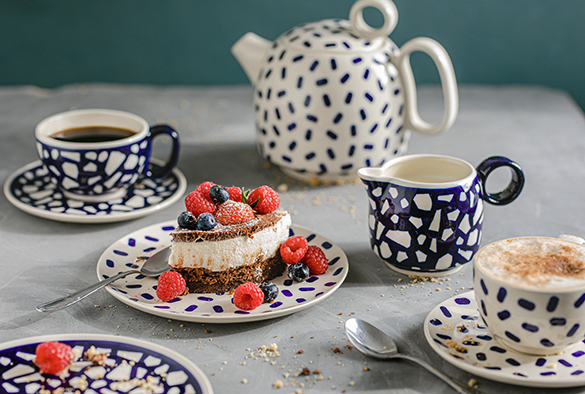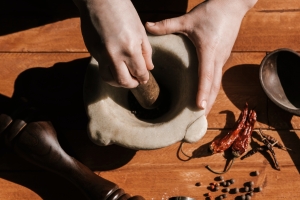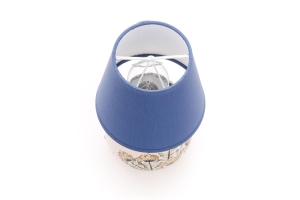History of Polish Pottery and Rich Tradition of Polish Stoneware

Source
Polish pottery, also known as Polish stoneware, is a centuries-old tradition deeply rooted in the culture of Poland, especially Silesia. This exquisite form of ceramics has a rich history and continues to captivate people with its unique designs and durability.
In this article, we will explore the origins of Polish pottery, the significance it holds in Polish culture, popular designs and patterns, the modern production process, and tips for caring for these timeless pieces.
Key Takeaways:
- Polish pottery, also known as Polish stoneware, is a durable and intricately designed ceramic with cultural significance in Poland, requiring specific care to maintain its condition.
- Known for its vibrant and detailed patterns, each design in Polish pottery carries its own unique symbolism, offering pieces with individual stories.
- Bolesławiec, the birthplace of Polish pottery, houses numerous ceramic artists who handcraft each piece, making its pottery highly sought after by collectors worldwide.
- The modern production of Polish Pottery combines traditional techniques and modern tools, with the firing process playing a critical role in maintaining its quality. Authentic pottery can be found in Bolesławiec or certified online stores.
What is Polish Pottery?
Polish pottery, also referred to as Polish stoneware, is a type of high-quality ceramic that is known for its exceptional durability and intricate hand-painted designs. It is primarily made from white clay and feldspar, which gives it a distinctive appearance. Polish pottery is fired at high temperatures, making it strong and resistant to chipping and cracking. It is often used for tableware such as plates, mugs, and bowls.
Polish pottery is popular for its unique colors and patterns, ranging from traditional folk motifs to more contemporary designs. The hand-painted decorations are done using special brushes and techniques, making each piece of pottery one-of-a-kind. The vibrant colors of Polish pottery are achieved through a glazing process that involves multiple firings at different temperatures.
Apart from its aesthetic appeal, Polish pottery is also highly functional. It is microwave, dishwasher, and oven-safe, making it convenient for everyday use. Its durability ensures that it can withstand the rigors of daily life without losing its beauty or functionality.
The History of Polish Pottery
Origin of Polish Pottery
The origins of Polish pottery can be traced back to the 14th century in the region of Silesia, which is now part of Poland. This area had an abundance of natural resources, including high-quality deposits of white clay, an essential ingredient for pottery production. The rich clay found in Silesia, combined with the craftsmanship of local potters, led to the birth of Polish pottery.
The technique of producing Polish pottery involves hand-thrown or wheel-thrown methods. Artisans shape the clay into various forms, including plates, bowls, mugs, and vases. After the initial shaping, the pottery is left to dry before being glazed, decorated, and fired in a kiln.
The distinctive decoration of Polish pottery is known for its vibrant colors and intricate patterns. Traditional motifs often include floral designs, peacocks, and abstract geometrical patterns. The vibrant blue color, known as "cobalt blue," is one of the most characteristic and iconic elements of Polish pottery.
During the 18th century, Polish pottery gained popularity in Europe, becoming coveted by royalty and nobility. The high-quality clay and skilled craftsmanship made Polish pottery highly sought after, not only for its beauty but also for its durability and functionality.
Development of Polish Stoneware
One of the key figures in the development of Polish pottery was Johann Gottlieb Altmann. In the early 19th century, Altmann brought innovative techniques and designs to the industry, revolutionizing the art of Polish ceramics. His contributions laid the foundation for the distinctive style and quality that defines Polish pottery today. However, the production of Polish pottery faced challenges during the 19th and 20th centuries due to political and economic turmoil, including wars and changes in borders. Despite these setbacks, the tradition of pottery making in Poland persevered and experienced a revival in the late 20th century.
Significance of Polish Pottery in Polish Culture
Polish pottery holds deep cultural significance in Poland. It has become an integral part of Polish identity and is celebrated as a symbol of craftsmanship and tradition. The beauty and functionality of Polish pottery have made it a popular choice both domestically and internationally. Many artisans and small family-owned workshops continue to produce Polish pottery using traditional methods and techniques, ensuring the preservation of this rich cultural heritage.
The popularity of Polish pottery has spread beyond Poland's borders, with stores and collectors around the world showcasing and selling these unique pieces. Polish pottery has become not only a practical household item but also a cherished decorative and collectible art form, beloved for its beauty and cultural significance.
Boleslawiec Pottery
Bolesławiec: The Heart of Polish Pottery
Bolesławiec, a small town in southwestern Poland, is widely recognized as the birthplace and heart of Polish pottery. It is home to numerous ceramic artists and cooperatives who continue to produce authentic and high-quality pieces. The town has a rich history of pottery production, and its workshops and stores attract visitors from around the world.
The local artisans began producing pottery in a distinctive style that incorporated intricate designs and vibrant colors. These signature patterns, such as the recognizable blue and white designs, became synonymous with Polish pottery.
Bolesławiec's pottery is highly sought after by collectors and enthusiasts around the world. Its unique, hand-painted designs and excellent craftsmanship have earned it a reputation for being some of the finest pottery available. Authentic Boleslawiec pottery is distinguished by a stamp on the bottom of each piece, guaranteeing its authenticity.
In addition to the workshops, Bolesławiec is home to numerous stores and outlets where visitors can purchase pottery directly from the source. These stores offer a wide selection of designs and styles, allowing visitors to find the perfect piece to take home as a memento of their visit.
Traditional Techniques and Designs
In Boleslawiec, traditional techniques are still used to create Polish pottery. Skilled potters handcraft each piece using molds and stamps to create unique motifs and patterns. The pottery is then glazed and fired at high temperatures, resulting in the vibrant and durable finished product that is characteristic of Polish pottery.
Visitors to Boleslawiec can explore the town's historical pottery workshops and studios, witnessing the process from start to finish. Skilled artists demonstrate their craft, shaping and painting each piece by hand, using traditional methods passed down through generations. Many of these workshops also offer workshops and classes for those interested in learning pottery techniques.
Boleslawiec Pottery Today
Boleslawiec pottery has gained global recognition for its exceptional quality and craftsmanship. It is highly sought after by collectors and enthusiasts who value its beauty and authenticity. Today, the town of Bolesławiec is a hub for pottery lovers, with numerous stores and galleries showcasing a wide variety of designs and styles.
Popular Designs and Patterns
Celebrated Styles in Polish Pottery
Polish pottery is known for its intricate designs and patterns, each with its own unique story. Some of the most celebrated styles include the "Unikat" collection, which features one-of-a-kind hand-painted designs, and the "Ceramika Artystyczna" line, which showcases the creativity and artistry of Polish ceramic artists.
Meaning Behind the Patterns
Each pattern in Polish pottery carries its own meaning and symbolism. For example, the "Bunzlauer" pattern is inspired by German and Czech folk art and represents harmony and unity. The brown glaze often seen in Polish pottery symbolizes the earth and the connection to nature.
Modern Production and Manufacturing Process
Techniques and Tools Used in Making Polish Pottery
Modern production of Polish pottery involves a combination of traditional techniques and modern tools. Skilled potters use pottery wheels, molds, and stamps to shape the clay into various forms. The pieces are then glazed and fired in kilns at high temperatures, resulting in the beautiful and durable pottery that is beloved worldwide.
Factors Affecting the Quality of Polish Pottery
Several factors contribute to the quality of Polish pottery. The type and quality of clay used, the skill and craftsmanship of the potter, and the firing process all play a role in producing pottery of exceptional quality. The use of traditional methods and attention to detail are also essential for creating pieces that embody the rich tradition of Polish stoneware.
Caring for Polish Pottery
Tips for Cleaning and Maintaining Polish Pottery
- To ensure the longevity of Polish pottery, proper care is essential. It is recommended to hand wash the pottery using mild soap and warm water.
- Avoid using abrasive materials or harsh cleaning agents that could damage the delicate glaze.
- It is best to avoid extreme temperature changes, such as placing hot pottery directly into cold water, as this can cause the pottery to crack.
- When storing Polish pottery, it is important to protect it from impacts and scratches. Stack the pottery carefully with padded dividers, or use a soft cloth or paper towel to separate each piece.
- To prevent staining, it is recommended to avoid contact with foods or liquids that may discolor the pottery, such as strongly colored or acidic substances. If any staining does occur, a baking soda and water paste can be used to gently scrub away the marks.
- Polish pottery should also be shielded from direct sunlight, as prolonged exposure can cause fading and discoloration. Displaying the pottery in a cabinet or behind glass can help protect it from UV rays.
- To maintain the beauty and shine of the pottery, a light coat of mineral oil can be applied periodically. This will help to nourish the glaze and keep it looking vibrant.
Where to Buy Polish Pottery
Recommended Places to Purchase Authentic Polish Pottery
Authentic Polish pottery can be found in a variety of shops and online stores. When looking to purchase Polish pottery, it is important to ensure its authenticity. One of the most reputable places to buy Polish pottery is directly from the town of Bolesławiec, where you can find the widest selection of designs and styles. It is also advisable to look for certified sellers and reputable websites that specialize in Polish pottery.
Appreciating the Rich Tradition of Polish Stoneware
Polish pottery has a deep-rooted history and holds significant cultural value in Poland. Its unique designs, exceptional quality, and rich tradition make it a cherished form of stoneware. Whether you are a collector or simply appreciate the beauty of handcrafted ceramics, Polish pottery will continue to captivate and inspire for generations to come.
Polish pottery, also known as Bolesławiec pottery, originated in the town of Bolesławiec in southwestern Poland. It has been produced for over 200 years and has become renowned worldwide for its distinctive patterns and durability.
Polish pottery is not only cherished for its aesthetic appeal and functionality, but it also holds significant cultural value in Poland. The craft of pottery making has been an important part of Polish culture for centuries, and the tradition of handcrafting each piece continues to be passed down through families and communities.
Today, Polish pottery is highly sought after by collectors and enthusiasts around the world. Its unique designs and exceptional quality have made it a symbol of Polish heritage and craftsmanship. Whether used for everyday dining or proudly displayed as decorative pieces, Polish pottery continues to captivate and inspire with its beauty and rich tradition.
FAQ
How long has the history of Polish Bolesławiec pottery been?
The history of Polish Bolesławiec pottery dates back to an extremely long time. It has been produced for over 750 years, making it one of the oldest traditions in Poland.
Is Bolesławiec pottery still made today?
Yes, Bolesławiec pottery is still produced today. In fact, it has gained international recognition and is exported to various parts of the world.
What is the most recognizable aspect of Bolesławiec pottery?
The most recognizable aspect of bolesławiec pottery is its distinctive blue and white patterns. These patterns are inspired by the natural surroundings of the region and showcase the beauty of nature.
Where can I buy authentic Bolesławiec pottery?
Authentic Bolesławiec pottery can be purchased from various sources, including specialty stores, online retailers, and even directly from the pottery workshops in the village of Boleslawiec.
What is the role of manufaktura in the production of bolesławiec pottery?
Manufaktura is a renowned pottery workshop in Boleslawiec that specializes in the production of bolesławiec pottery. It is known for its high-quality craftsmanship and authentic designs.
Is there a museum dedicated to ceramics in Boleslawiec?
Yes, there is a museum of ceramics in Boleslawiec where visitors can learn about the history and evolution of Bolesławiec pottery. It showcases various pieces of pottery and provides insights into the techniques used in its production.
What is Bunzlauer pottery?
Bunzlauer pottery is another name used to refer to bolesławiec pottery. The term "Bunzlauer" originated from the name of a town in Germany where the pottery gained popularity.











Validate your login
Sign In
Create New Account